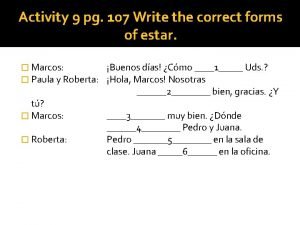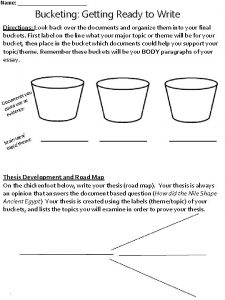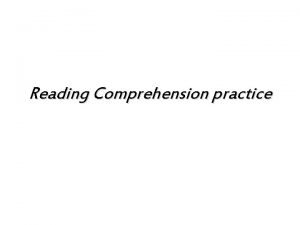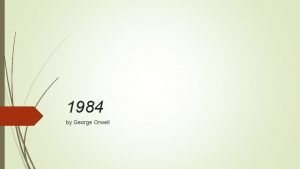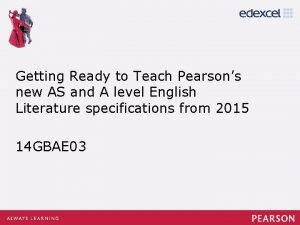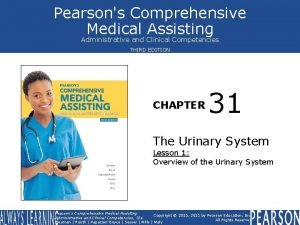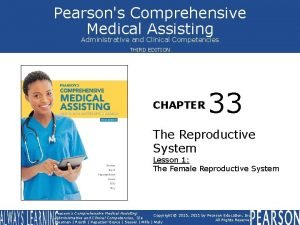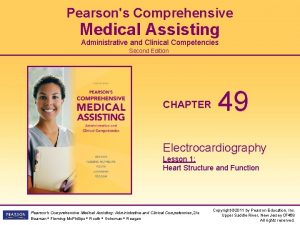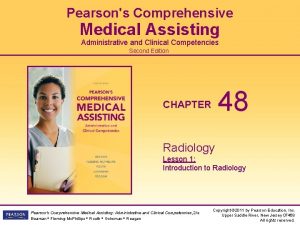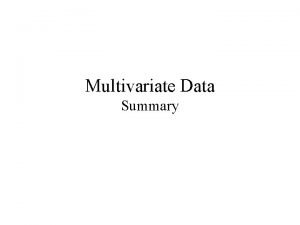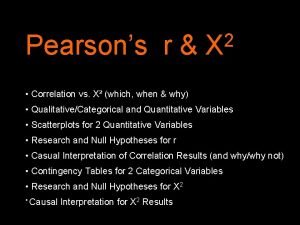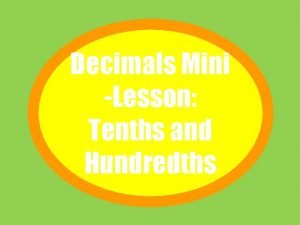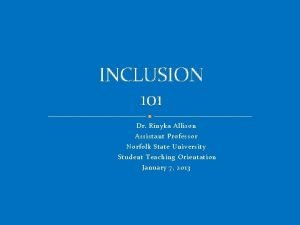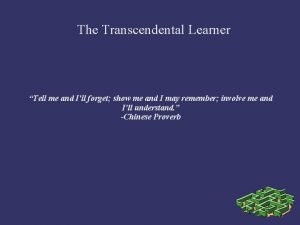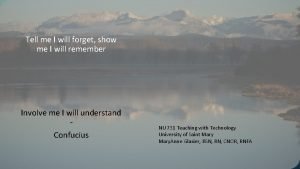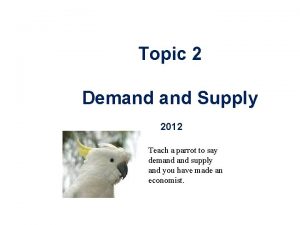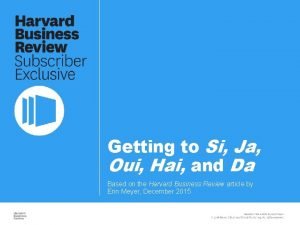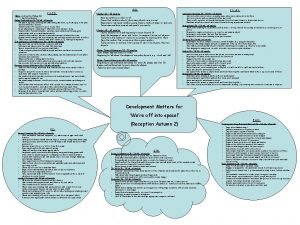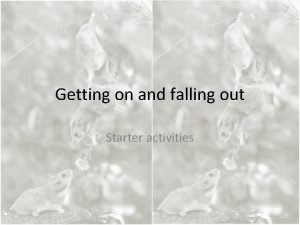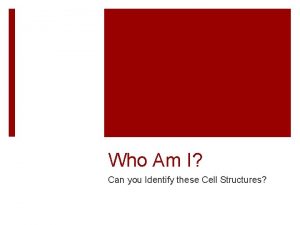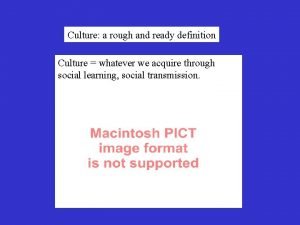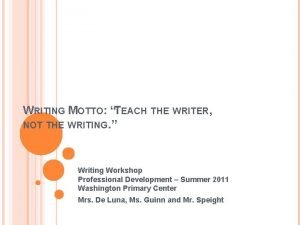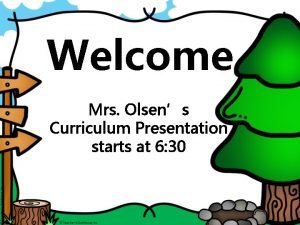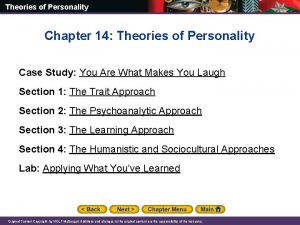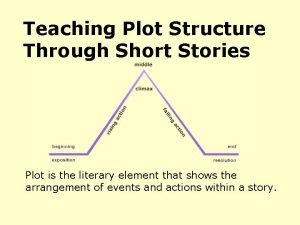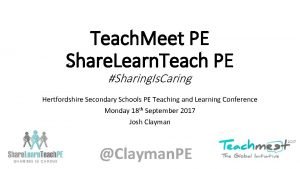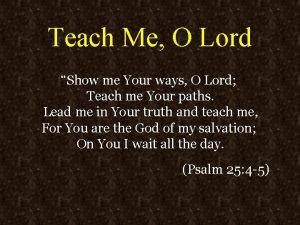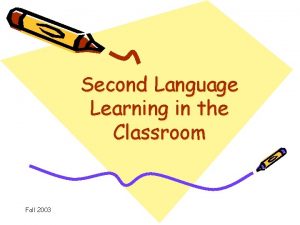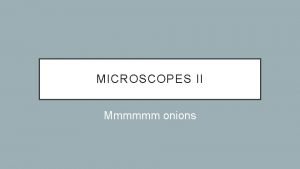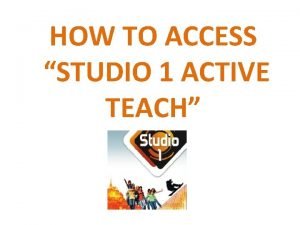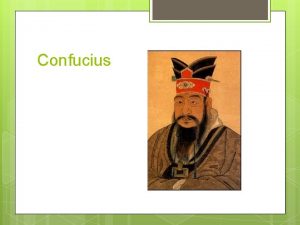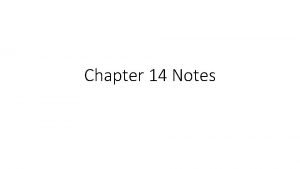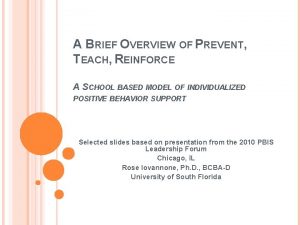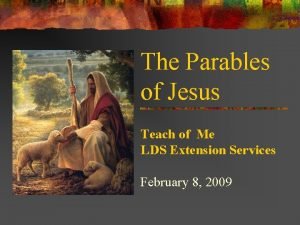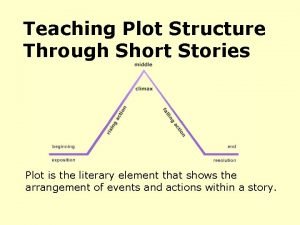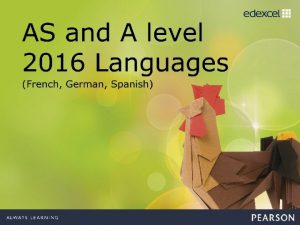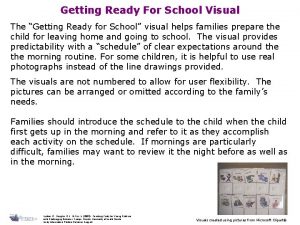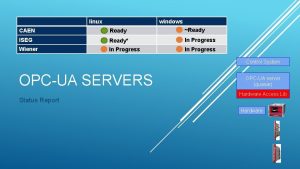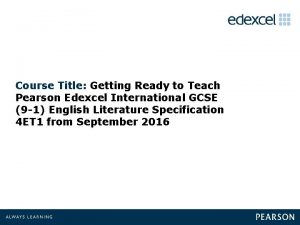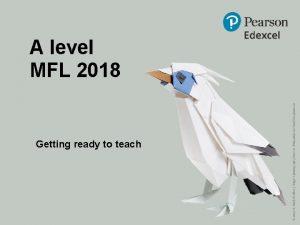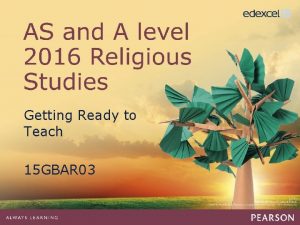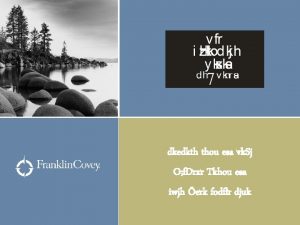Getting Ready to Teach Pearsons new AS and






























































- Slides: 62

Getting Ready to Teach Pearson’s new AS and A level English Literature specifications from 2015 14 GBAE 03

Aims and Objectives During the session you will: - Consider the structure, content and assessment of these new qualifications, and the support available to guide you through these changes - Explore possible teaching and delivery strategies for the new qualifications, including co -teaching AS and A level - Take part in planning activities - Have the opportunity to network and share ideas with other teachers

The changes

Changes to all A Levels • In new A level the AS level will be a separate, linear qualification and the grade will not contribute to the overall A level Grade • The content of the AS can be a subset of the A level content to allow co-teachability with the A level • HE/Russell Group involvement in subject content.


Changes to subject criteria • • • 20% coursework at A level – no AS coursework 8 texts – reduced from 12, to facilitate in-depth reading and move away from ‘secondary texts’ 6 reduced to 4 at AS Changes to dates ranges: post-1990 becomes post 2000; greater emphasis on pre-1900 texts (3 out of 8) Unseen assessment will be a compulsory requirement Less emphasis on comparison in favour of ‘connections’

Changes to Assessment Objectives AS/A level % AO 1 Articulate informed, personal and creative responses to literary texts, using associated concepts and terminology, and coherent, accurate written expression 20 -30 AO 2 Analyse ways in which meanings are shaped in literary texts 20 -30 AO 3 Demonstrate understanding of the significance and influence of the 20 -30 contexts in which literary texts are written and received AO 4 Explore connections across literary texts 10 -15 AO 5 Explore literary texts informed by different interpretations 10 -15

Our specification

A and AS level at a glance Component Assessment Method Weighting 1 – Drama Examination 30% 2 – Prose Examination 20% 3 – Poetry Examination 30% 4 – Coursework 20% 1 – Drama and Poetry Examination 60% 2 – Prose Examination 40% A level AS level

A level text coverage There are two texts in each component Component Text 1 Text 2 Drama Shakespeare ‘other’ drama* Prose Pre-1900 prose Prose* Poetry Post 2000 poetry Poetry movement/poet* Coursework Chosen text All new Literature specifications require 3 out of the 8 texts to be pre 1900 * Indicates where a third pre-1900 text can be studied Remember to complete and submit the pre-1900 checking form before the start of the course.

Component 1: Drama Tragedy: Shakespeare: Hamlet, King Lear, Othello, Anthony and Cleopatra Other drama: The Duchess of Malfi, A Streetcar Named Desire, Doctor Faustus, The Home Place OR Comedy: Shakespeare: The Taming of the Shrew, A Midsummer Night’s Dream, Twelfth Night, Measure for Measure Other drama: Waiting for Godot, The Importance of Being Earnest, The Pitmen Painters, The Rover


Component 3: Poetry Poems of the Decade: An Anthology of the Forward Books of Poetry 2002– 2011. The Medieval Period (1350 -1500) OR Geoffrey Chaucer The Victorians (1837 -1900) OR Christina Rossetti The Metaphysical Poets (1600 -1690) OR John Donne Modernism (1900 -1939) OR T. S. Eliot The Romantics (1780 -1830) OR John Keats The Movement (1950 -1970) OR Philip Larkin

Texts at AS Level AS texts are taken from the A level options: • 2 x prose texts, including at least 1 pre-1900 text (same themes and texts as A level) • 1 x other drama text (same other drama texts as A level) • 1 x selection of poems from Poems of the Decade: An Anthology of the Forward Books of Poetry 2002– 2011 Allows for complete co-teachability

Co-teachability Year 1 • • • Year 2 One collection of post-2000 poetry • 1 Drama text (non. Shakespeare) • • 2 prose texts (including at least one pre-1900 text) One Shakespeare play plus selection of related essays from the Shakespeare Critical Anthology Approaches to unseen poetry One collection of poetry from a selected time period, either by movement or poet Teachers may wish to begin preparation for the coursework with A level 2 -year students towards the end of year 1, whilst the AS students prepare for their AS examinations. Therefore, the 2 coursework texts may be covered in year 1, year 2 or a combination of both, as appropriate.

Planning

Text coverage activity • Using the text coverage handout, which of your currently taught texts might you want to keep? Where could these be used? • What opportunities for introducing new texts does it present? • How are you meeting the pre-1900 requirement? Discuss your thoughts with a colleague.

High level planning activity Look at the 3 planning models in your pack, and the questions for consideration. • Discuss the merits of each with a colleague • Using the blank planning sheet draft a possible 2 year plan for your department / class Examples of detailed course planners and schemes of work can be found on the Edexcel website.

Assessment – A level

HOLISTIC MARKS SCHEMES Look at the example mark scheme for ‘other’ drama in the sample assessment materials Integrated assessment objectives – no longer separate grids for each AO Even weighting of marks across the targeted AOs (any exceptions are minimal, so that the approach should still be even handed)

Component 1 - Drama Overview of assessment 1 DRAMA Paper length: 2 hours and 15 minutes 30%, 60 marks Section A: Shakespeare One essay question from a choice of two on the studied Shakespeare text. (AO 1, AO 2, AO 3, AO 5 assessed) Section A 35 marks Section B: Other drama One essay question from a choice of two on the studied drama text. (AO 1, AO 2, AO 3 assessed) Section B 25 marks

Shakespeare Or Key Points • AO 1, AO 2, AO 3, AO 5 • The student must be able to discuss the play in the light of other critical interpretations • The student must also explore the play’s contexts

How can students demonstrate their engagement with different interpretations? (AO 5)

Shakespeare Critical Anthology • Free hard copy to every student. Order yours here. • Essays on the genres of tragedy and comedy, as well as specific writing on the students’ selected play. • Produced in association with University College London. Spend a few minutes looking at the relevant critical anthology for your chosen Shakespeare text. How might you incorporate this resource into your teaching? Take a look at the Using Literary Criticism lesson plan for some further ideas.

How might students use the critical anthology? • • Understand the position being put forward Compare the critical position with own position – identify points of similarity and difference Compare the critical position with that of other students in class, or another critic Agree with a critical point and find other examples in the play to further support it Disagree with a critical perspective, and find evidence to support your own view Refine the critics’ position – identify elements you could support, and those which you would develop further Select particular key quotations to support or contrast with your own reading

Extract from a student response However, by the time we get to Act 4, the comedy of the revenge plot dies as Malvolio is imprisoned in ‘hideous darkness’ and is abused by Feste, who tries to prove him mad. Even Sir Toby believes this is excessive and wants to be ‘well rid of this knavery. ’ There is an argument that says Malvolio’s imprisonment is intended to reflect Shakespeare’s own antipathy towards the puritans. It is true that the darkness could symbolise Malvolio’s moral blindness or lack of self-knowledge but, to me, and probably to a modern audience generally, his treatment ceases to be comic and becomes brutally unfair.

How can students demonstrate their engagement with different contexts? (AO 3)

Extract from a student response …Perhaps as a more civilised society we have more of a moral compass – morality is not innate but dependent on environment and society. It is interesting to ask what Shakespeare’s attitude to Malvolio was. At a time when theatres were banished to the margins of London by puritanical authorities we may assume that Shakespeare may have intended for the audience to unite against Malvolio and enjoy his humiliation. Thirty-three years after Shakespeare’s death, however, the Puritans took power after the beheading of Charles I. Theatres, including Shakespeare’s Globe, were closed. It is as if Malvolio’s revenge is directed not only at the audiences who mocked him, but also at his creator himself.

‘Other’ Drama Or Key Points • AO 1, AO 2, AO 3 • The student must explore the play’s contexts • There is NO requirement to engage with other interpretations

Component 2 - Prose Overview of assessment 2 Prose Paper length: 1 hour One comparative essay question from a choice of two on the studied prose texts text. (AO 1, AO 2, AO 3, AO 4 assessed) 20%, 40 marks

PROSE OR Key Points • AO 1, AO 2, AO 3, AO 4 equally weighted • Students must explore the contexts of the novels • An additional focus is on making connections between the texts – ‘Compare’ will be a command word in the question. • One of the texts must be pre-1900

How should students make links and connections between texts? (AO 4)

Extract from a student response In conclusion, Attwood uses Offred as her narrator in order to present how the abuse of power by the hierarchy depends upon the repression of most of the population, therefore creating a dystopian novel. Attwood presents a woman which the readers can relate to, and therefore can attach themselves to emotionally, creating an engaging narrative. On the other hand, Shelley uses multiple narrators, which interlink and blur together, in order to create an uncertainty for her reader, and enforce the gothic form of her novel. By using three different narrators, Shelley provides distance between her tale and the reader…

Demands of AO 4 Level 1 1– 4 Descriptive • Demonstrates limited awareness of connections between texts. Describes the texts as separate entities. Level 2 5– 8 General exploration • Identifies general connections between texts. Makes general cross references between texts. Level 3 9– 12 Clear relevant exploration • Makes relevant connections between texts. Develops an integrated approach with clear examples. Level 4 13– 16 Discriminating exploration • Analyses connections between texts. Takes a controlled discriminating approach to integration with detailed examples. Level 5 17– 20 Critical and evaluative • � Evaluates connections between texts. Exhibits a sophisticated connective approach with sophisticated use of examples.

Ways to teach links and connections in lessons • • • Continuum lines (statements to agree, qualify or disagree with are placed at either end of a line and students are asked to place texts/ parts of texts at points in the line in relation to the opposing terms) Scaffolding plans for responding to comparison questions Combing sections of the texts for similarities / differences Exploring the connecting themes and asking students to find textual illustrations for these Using Venn diagrams to compare characters / themes / modes of presentation etc. Other ideas?

Component 3 - Poetry Overview of assessment 3 POETRY Paper length: 2 hours and 15 minutes Section A: Contemporary Poetry One essay question from a choice of two comparing an unseen modern poem and one named poem from the studied collection (AO 1, AO 2, AO 4 assessed). Section B: Poetry Collections One essay question from a choice of two on the studied poetry period or author. (AO 1, AO 2, AO 3 assessed) 30%, 60 marks Section A 30 marks Section B 30 marks

Contemporary Poetry or Key Points • AO 1, AO 2, AO 4 • All modern poetry (post 2000) • Students must compare poems • BOTH poems will be printed in the A level paper i. e. the unseen poem and the optional studied comparative poems

Poets from ‘Poems of the Decade’ Vicki Feaver: ‘The Gun’ Sinéad Morrisey: ‘Genetics’ Listen to the poets reading their poems from the Poems of the Decade anthology. Follow them in you anthology.

Coverage of the poems – groupings poems for teaching How far can the ‘I’ of a poem ever be identified with ‘the poet’? • Simon Armitage ‘Chainsaw Versus the Pampas Grass’ • Eavan Boland ‘Inheritance’ • Ian Duhig ‘The Lammas Hireling’ Consider the methods used to convey childhood: • Helen Dunmore ‘To My Nine-Year-Old Self’ • John Burnside ‘History’ • Julia Copus ‘An Easy Passage’ There are many ways in which the poems for study might be grouped. A range of suggested groupings and suggested seminar ideas, are available on the website.

Using the Unseen Poetry resource • ‘how to approach unseen’. Advice from: – an academic – a poet and editor of ‘Poetry Review’ – a skilled sixth form teacher Discover the Unseen Poetry Preparation anthology here.

Approaching Unseen Poetry ‘When I read the unseen response essay I hope to get a sense that the writer is someone who understands how poetry works and what it is for…. a sense that poems are not intended to be studied in classrooms or written about in exams…’ Gary Snapper ‘Look at the poem first. Some poems sit comfortably on the page. They are tidy and well behaved as Shakespeare’s sonnets are…Others sprawl all over it, reluctant to be confined to its margins, like the great rebellious poems of Pablo Neruda…Then read the poem. No, don’t just read it. LISTEN to it. ’ Maurice Riordan ‘

Approaching Unseen Poetry • Sometimes the questions we ask are more important than their answers and no close reading can explain everything about a really good poem. If a close reading, by some chance, ever managed to do that, we would have nothing to bring us back to the poem again. ’ Peter Barry • ‘Who better to teach you about contemporary poetry than the poets themselves. ’ Edexcel

Poetry movement or poet or Key Points • AO 1, AO 2, AO 3 • Students need to engage with contexts • No comparisons required

Component 4 - Coursework Overview of assessment 4 COURSEWORK One extended comparative essay referring to two texts (2500 -3000 words) (AO 1, AO 2, AO 3, AO 4, AO 5) 20%, 60 marks

COURSEWORK Key Points Any TWO texts of any period or genre other than texts that have already been studied • AO 1, AO 2, AO 3, AO 4, AO 5 • Students have to link the texts, and engage with contexts and alternative interpretations. • Students as independent learners. • There are lots of example text and task combinations in the getting started guide

Activity • Consider the list of example coursework tasks and texts in your packs. • Using either the other texts in the specification, or your own ideas, devise two further coursework tasks. • Use the provided examples to help you in creating an appropriate task title. If you need support with your coursework texts or tasks, or confirmation of their suitability, e-mail the coursework advisory service.

Assessment – AS level

Component 1 – Poetry and Drama Overview of assessment 1 Paper length: 2 hours 60%, Section A (poetry) One essay from a choice of two on a named poem from the studied collection, plus a free choice of second poem (AO 1, AO 2, AO 4 assessed) 72 marks Section A 24 marks Section B (drama) One essay from a choice of two on their studied play. (AO 1, AO 2, AO 3, AO 5 assessed) Section B 48 marks

Component 1 – Poetry or Key Points Poetry: • AO 1, AO 2, AO 4. • No unseen poetry but still all post-2000 and the same Anthology (and same poems) are used.

Component 1 – Drama Or Key Points Drama: • AO 1, AO 2, AO 3, AO 5 • No Shakespeare • AO 5 is addressed in the question: ‘…in the light of this comment…’ (no requirement to draw in additional critical materials from outside the drama text)

Component 2 - prose Overview of assessment 2 Paper length: 1 hour One essay from a choice of two on the studied prose texts. (AO 1, AO 2, AO 3, AO 4 assessed) 40%, 44 marks

Component 2 - Prose or Key Points • AO 1, AO 2, AO 3, AO 4 – exactly as A level.

Supporting you through the changes

Teaching and Learning Resources Checklist Shakespeare Critical Anthology Unseen Poetry Preparation Anthology Poems of the Decade – teacher guide Getting Started Guide Course planners Schemes of work Lesson plans Exemplars Order your hard copies of the critical anthologies from Stationery box

Frequently Asked Questions

Tracking progress • • • Our new qualification will be accompanied by an additional set of papers prior to first teaching, for you to use as a mock exam or earlier in the course. Results. Plus provides the most detailed analysis available of your students’ exam performance. It can help you to identify topics and skills where students could benefit from further learning. Mock Analysis provides analysis of past exam papers which can be set as mock exams. www. edexcel. com/resultsplus

Tracking progress Exam. Wizard – help track progress • allows you to create your own tests online using FREE past paper questions. Contains a huge bank of past Edexcel exam questions and support materials to help you create your own mock exams, topic tests, homework or revision activities. • Helps you search for past papers, mark schemes and examiners’ reports. • www. examwizard. co. uk

Contact information • • • Subject Advisor email: Teaching. English@pearson. com Subject Advisor telephone number: 0207 010 2183 Subject page link: http: //www. edexcel. com/quals/gce 15/englang/Pages/default. aspx www. edexcel. com/contactus www. edexcel. com/learningforabetterfuture

Statistics If you would like to know more about examination statistics, you may find these links of interest to you. Examination Results Statistics www. edexcel. com/iwantto/Pages/stats. aspx Results statistics summarise the overall grade outcomes of candidates sitting Edexcel examinations. Grade Boundaries http: //www. edexcel. com/iwantto/Pages/grade-boundaries. aspx This page shows the minimum marks needed to achieve a certain grade for all UK and international examinations. Also refer to the examiners report which is available for download with other documents.

Statistics continued Results. Plus www. edexcel. com/resultsplus • Edexcel’s free online service giving instant and detailed analysis of your students’ exam and mock performance • see your students’ scores for every exam question • understand how your students’ performance compares with Edexcel national averages

Training Wide range of training events for 14/15 • General Qualifications • Vocational Qualifications Audience • UK • International Choice of Delivery methods to suit you and your centre • F 2 F • Online • Centre-based More information http: //www. edexcel. com/training WHAT OTHER TRAINING WOULD YOU FIND USEFUL?

Thank you We constantly look to improve the training we provide Please let us know what you thought of the training by completing our online feedback form for the opportunity to win a £ 100 Amazon. co. uk Gift Card.
 Stay ready to keep from getting ready
Stay ready to keep from getting ready The verb estar page 107 answers
The verb estar page 107 answers The secret of getting ahead is getting started
The secret of getting ahead is getting started Bucketing - getting ready to write
Bucketing - getting ready to write Birthday party reading comprehension
Birthday party reading comprehension Getting ready to cook
Getting ready to cook Ready cook safety
Ready cook safety Getting ready
Getting ready Getting ready for the real world answers
Getting ready for the real world answers Pearsons exam wizard
Pearsons exam wizard Pearsons
Pearsons Pearsons
Pearsons Pearsons
Pearsons Pearson comprehensive medical assisting
Pearson comprehensive medical assisting Pearsons
Pearsons Pearsons r
Pearsons r Ready for a new challenge
Ready for a new challenge You tell me and i forget
You tell me and i forget Model tenths and hundredths
Model tenths and hundredths How to teach hcf and lcm
How to teach hcf and lcm Teach and train fccla rubric
Teach and train fccla rubric One teach, one assist pros and cons
One teach, one assist pros and cons Teach me and i'll forget
Teach me and i'll forget Confucius tell me and i will forget
Confucius tell me and i will forget Teach a parrot to say supply and demand
Teach a parrot to say supply and demand Getting to si, ja, oui, hai, and da
Getting to si, ja, oui, hai, and da Seal getting on and falling out
Seal getting on and falling out Getting on and falling out
Getting on and falling out What organelles name means colored bodies
What organelles name means colored bodies New york, new jersey, pennsylvania, and delaware
New york, new jersey, pennsylvania, and delaware New oil and new wineskin
New oil and new wineskin Both new hampshire and new york desire more territory
Both new hampshire and new york desire more territory Slidetodoc.com
Slidetodoc.com New classical and new keynesian macroeconomics
New classical and new keynesian macroeconomics Chapter 16 toward a new heaven and a new earth
Chapter 16 toward a new heaven and a new earth Neil thisse is a loyalist answers
Neil thisse is a loyalist answers New classical and new keynesian macroeconomics
New classical and new keynesian macroeconomics Rough and ready definition
Rough and ready definition Helnaren
Helnaren Teach the writer not the writing
Teach the writer not the writing Https://teach.classdojo.com
Https://teach.classdojo.com What does the psychoanalytic approach to personality teach
What does the psychoanalytic approach to personality teach Their eyes were watching god chapter 10
Their eyes were watching god chapter 10 Teaching plot structure
Teaching plot structure Teaching grammar to young learners
Teaching grammar to young learners Share learn teach
Share learn teach How to respond to teach me your ways
How to respond to teach me your ways Teach what is teachable proposal
Teach what is teachable proposal Microteaching definition
Microteaching definition Https://teach.classdojo.com
Https://teach.classdojo.com Micro teach lesson plan
Micro teach lesson plan Ukraine dt
Ukraine dt Intel teach to the future
Intel teach to the future Active teach online
Active teach online Where did confucianism begin
Where did confucianism begin Sung by flaming tongues above
Sung by flaming tongues above What does the psychoanalytic approach to personality teach?
What does the psychoanalytic approach to personality teach? Prevent teach reinforce
Prevent teach reinforce Suicide chain teach
Suicide chain teach Parables of jesus lds
Parables of jesus lds The challenger sale summary by chapter
The challenger sale summary by chapter Short stories for plot diagram
Short stories for plot diagram Teach them diligently nashville
Teach them diligently nashville

